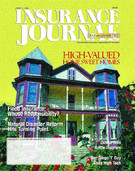In his book, “The Lexus and the Olive Tree,” Pulitzer Prize-winning journalist Thomas L. Friedman defines globalization as “the inexorable integration of markets, nation-states and technologies to a degree never witnessed before-in a way that is enabling individuals, corporations and nation-states to reach around the world farther, faster, deeper and cheaper than ever before.”
In keeping with this concept of globalization, American International Group (AIG) has realigned its property/casualty insurance operations to form the AIG WorldSource Division. WorldSource, which will be based in New York City, is made up of the North American Division of American International Underwriters (AIU)-which serves the overseas insurance needs of U.S.-based multinationals-together with the Domestic Brokerage Group (DBG). The Foreign Multinational Division of AIG Risk Management will also become part of WorldSource with the aim of addressing the needs of foreign companies with U.S. subsidiaries.
“The mission for WorldSource is to provide a one-stop shopping capability for multinationals with overseas exposures,” said Gordon Knight, the new president of the AIG WorldSource Division. Knight, who joined AIG in 1982, most recently served as DBG regional vice president, Southeast region.
The decision to create WorldSource “was driven primarily off surveys of brokers and risk managers and various buyers of insurance,” Knight said. “There is a lot of anecdotal evidence as well as empirical evidence that insureds have been treated as two separate risk profiles-one for their domestic exposure, one for their international exposure-and we’re trying to bring a more seamless approach to that process.
“The trend has been toward trying to look at their risk more holistically and more as one. If you as a risk manager or as a broker decide to blend your programs together, we want the capability within one place within AIG to bring swift solutions to the table.”
In order to form WorldSource, AIG has drawn about 300 people from across the organization, most with multinational insurance experience in a variety of settings, including Europe, Latin America, Southeast Asia and the Far East. “One of the great strengths of AIG is being able to draw off those resources and build a structure and a team that has varied experience across a lot of different litigation environments and risk profile environments,” Knight said.
The result is a unique organizational structure that not too many insurance companies could duplicate. AIG’s presence in 130 locations around the world gives it the edge as far as hands-on service and the ability to provide product virtually anyplace a corporation would have a risk profile.
AIG’s CEO, Maurice R. “Hank” Greenberg, has used great innovation to build AIG into the largest U.S. commercial p/c insurance operation and a major player in world markets.
At the company’s recent annual meeting, Greenberg, 75, told some militant shareholders that he considered having more outside directors was “form over substance,” and that AIG’s second-to-none performance under his and the directors’ management spoke for itself. He has selected his son, Evan, to succeed him, but has no plans to retire.
AIG now has a complete range of financial service products and is investing heavily in new technology. Net income in 1999 rose 18.1 percent to a record $5.06 billion.
AIG’s recent acquisition of Sun America makes it a leading provider of retirement income plans, and with this added income, it reached $40.6 billion in revenues in 1999. The company’s return on equity was a remarkable 15.9 percent.
Part of AIG’s success lies in its ability to shift and adapt to the changing business climate-thus, the focus on globalization.
The new WorldSource division will feature a host of AIG specialty product categories in addition to property/casualty, “drawing off AIG’s product innovation in environmental, healthcare, product recall, trade credit, political risk [and] crisis management products,” according to Knight.
“The challenge in this era of globalization-for countries and individuals-is to find a healthy balance between preserving a sense of identity, home and community and doing what it takes to survive within the globalization system,” Friedman wrote in “The Lexus and the Olive Tree.”
AIG seems to have found that balance necessary for survival and success in today’s global society.
Topics USA Property Casualty AIG
Was this article valuable?
Here are more articles you may enjoy.


 Former CEO of Nonprofit P/C Statistical Agent Sentenced for Stealing Millions
Former CEO of Nonprofit P/C Statistical Agent Sentenced for Stealing Millions  Brown & Brown Files Suit Over Alleged Howden Poaching of 200+ Employees
Brown & Brown Files Suit Over Alleged Howden Poaching of 200+ Employees  ‘Door Knocker’ Roofers Were Everywhere. NC Farm Bureau Saw an Opportunity
‘Door Knocker’ Roofers Were Everywhere. NC Farm Bureau Saw an Opportunity  Underwriter, Actuary Fears of AI Drop; Work Needed on Collaboration
Underwriter, Actuary Fears of AI Drop; Work Needed on Collaboration 


